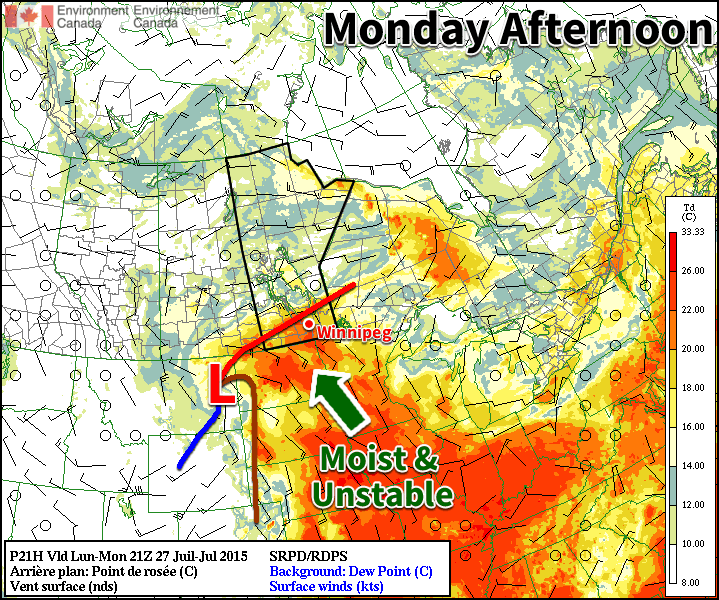This week will start out with a risk of thunderstorms. Monday will likely feature severe storms from eastern Saskatchewan into western Manitoba, while Tuesday may see storms through the Red River Valley and south-eastern Manitoba.

This Week
Monday
Today’s weather will have two key features; the risk of thunderstorms, and hot, humid conditions (these two attributes are linked incidentally). Temperatures are expected to climb into the low thirties across southern Manitoba, with the humidity pushing humidex values to around 40 in many areas, making it essentially a repeat of Sunday. However, there will also be a risk of severe storms in western Manitoba. This risk of storms will result from the combination of a hot, humid air mass over the region and a strong jet stream aloft. Any storms that do develop, particularly during the evening hours from south-eastern Saskatchewan into south-western Manitoba, could be very severe. There will be a risk of large to very large hail, damaging winds, heavy rain, and tornadoes. There is a risk that storms may fail to develop due to warm air aloft, although it seems more likely than not that there will be storms. A technical discussion on the thunderstorm risk over the next two days is available at the end of this post.
Tuesday
Tuesday will see a strong cold front push through southern Manitoba. The atmosphere ahead of this front will be unstable, potentially allowing some storms to develop ahead of it. The front is expected to pass through southern Manitoba relatively early in the day, limiting the potential for severe storms. However, if storms do develop early in the morning, we may see some strong cells push through the Red River Valley and south-eastern Manitoba before they exit into Ontario. Once the cold front passes, the humidity will drop noticeably, but temperatures will remain in the mid twenties with a gusty south-west wind.
Wednesday
Wednesday should be a fairly benign day in southern Manitoba, with breezy west winds and temperatures in the mid twenties. Skies should be mainly sunny and no significant precipitation is expected. For many thunderstorm-weary residents of Manitoba, this will come as a welcome break.
Technical Discussion
Monday
Dynamics:
An unseasonably strong upper trough will move across the southern prairies early this week. A lee cyclone will push onto the great plains early Monday, with the surface low centre being located near Dickinson, ND by Monday evening. A warm front will arc northwestward from the surface low to near Melita, MB and up toward the southern basin of Lake Winnipeg. A dryline will extend southward from the low, and a cold front will extend off to the south-west. This low will be associated with a strong upper trough, with 500 mb jet streaks of 50 kts over Wyoming and southern Saskatchewan on Monday evening. The exit region of a strong 80 kts 250 mb jet streak will be edging into the Dakota by Monday evening. In the low-levels a 30-40 kts LLJ will extend from the central plains into southern MB/SK. The result of the synoptic regime will be effective shear of 40-60 kts in the vicinity of the warm front.
Thermodynamics:
A moisture-rich air mass will be in place within the warm sector of the surface cyclone. 100 mb mean mixing ratios of 17-19 g/kg seem likely in the vicinity of the warm front, generating MLCAPE in the 3000-4000 J/kg range. A strongly veering low to mid-level wind profile will result in strong WAA in the 850-700 mb layer, generating sizeable capping inversions in most of the warm sector.
Overall Discussion:
Today will feature a moderate risk of severe thunderstorms from SE SK into SW MB. A moderately to extremely unstable air mass will be coincident with strong effective shear and strong ERSH. Main concern is the capping inversion that will result from low/mid-level WAA. It appears probably that some surface-based supercells may occur along the warm front, through the triple point region, and down the cold front today. Strong moisture convergence near the warm front, aided by the expected ejection of numerous weak vort maxes from the upper trough should trigger storms. Any storms that develop will produce large to very large hail, damaging winds, and potentially a few tornadoes. Tornado chances will likely be maximized through mid-evening at the LLJ increases and LCL heights decrease. The location of the warm front remains a question, as isentropic ascent of the LLJ on the warm front may generate extensive elevated convection in parts of southern SK. The primary surface-based risk may be pushed into ND under that scenario. Later in the period cold-pool mergers may allow for upscale growth into one or more forward-propagating MCSs. The cloud layer shear and LLJ orientations suggest a westward-moving system in ND that may impact parts of southern Manitoba, with the potential for severe weather primarily being along and south of the intl border. A second MCS may track NE-ward into the Interlake region. This second MCS would be non-severe owing to an unfavourable LLJ orientation – preventing strong dynamic lift for slabular convection – and decreasing deep layer shear.
Tuesday
A strong cold front will move through southern Manitoba on Tuesday, potentially triggering thunderstorms. Strong effective shear will be present in association with the frontal passage, however thermodynamic profiles suggest some capping to surface-based/near surface-based convection. Thus, it remains unclear if any storms will be possible before the front exits the province. Should storms develop, they may be severe with large hail and damaging winds being the main threats.
